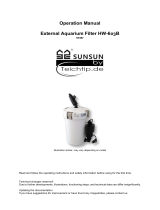© by WilTec Wildanger Technik GmbH Item 50107, 50108, 50114 Page 5
http://www.WilTec.de
http://www.aoyue.eu 02 2022-1
http://www.teichtip.de
After a period of 2–3 weeks, nitrifying filter bacteria will collect inside the filter sponges. These will require
some time to have an effect on the water. The pursued time that the used pond pump needs to fill the
filter once entirely, is about 1.5–3 minutes with the filter volumes named above. A well running filter thus
does not require cycles of 2–3 times per hour. Depending on the size of the pond, cycles of 1–2 per
10 hours are sufficient.
Calculation sample: A pump filters 10,000 ℓ⁄h. This means that an example pond with 100,000 ℓ volume
needs to be filtered once entirely per 10 hours. Thus in 24 hours, the pond water needs to be filtered
2.4 times by running through the pond filter. As the filter holds 250 ℓ of water and 10,000 ℓ can be
pumped through the filter per hour, this means that the filter is filled approximately 40 times per hour
with water. Therefore, the filter is filled entirely with water every 1.5 min. This means the water is pro-
cessed by the bacteria for 1.5 min, allowing for the water to be cleared and be released as clean water.
It is advisable to find a good compromise between these two calculations and your individual needs for
the pond to be filtered best.
Intended use
Products of this series are ideally suitable for the cleaning/purification of garden and fish ponds. If
properly used, the pond water will be effectively cleaned. Environmentally biodegradable filter materials
clean the water by means of mechanical filtration of bacteria and waste.
Features (partially optional)
• Water is cleaned more efficiently using a UV lamp before filtering it.
• The bio filter works especially strong due to its big filters and the multi-chamber system and has
an easy installing and cleaning thanks to its modular structure.
• The special water flow design that guides the water into the filtering chambers reduces the
pressure on the filter sponges and additionally lowers the maintenance requirements.
• The optimal design of the filter device enables an easy cleaning.
• Dirt indicator
• Temperature indicator
Commissioning
1. Open the top cover (1), remove the bio filter sponges (7), and wash them.
2. Wash the filter mat (8), too.
3. Place it back into its exact position.
4. Place the filter at least 2 m away from the pond edge, on a solid surface if a UV lamp is in use.
The filter must stand horizontally to prevent any overflow happening.
5. The outlet hose of the water cycle needs to be placed into the pond and the hose for the polluted
water to run away from should be placed into a sewage drain or into a flower bed with a slope
for the water to run off.
6. Saw the stepped hose adapter (20) to the required diameter.
7. Then place the hose onto the stepped hose adapter (20) and secure it with a hose clasp.
8. Place a gasket (19) on the thread of the stepped hose adapter (20). Then push the thread of
the stepped hose adapter (20) through the water outlet, and place another gasket (19) onto
the thread and screw the outlet nozzle (18) onto the thread.
9. Connect the other end of the hose with the pump.
10. For normal filter operation, leave the sealing cover (17) closed with a gasket (15). If you wish
to install a 2-inch hose permanently, remove the sealing cover and install the hose.
11. Install the top cover.
12. Connect the pump to electricity. The filter will start working then.









